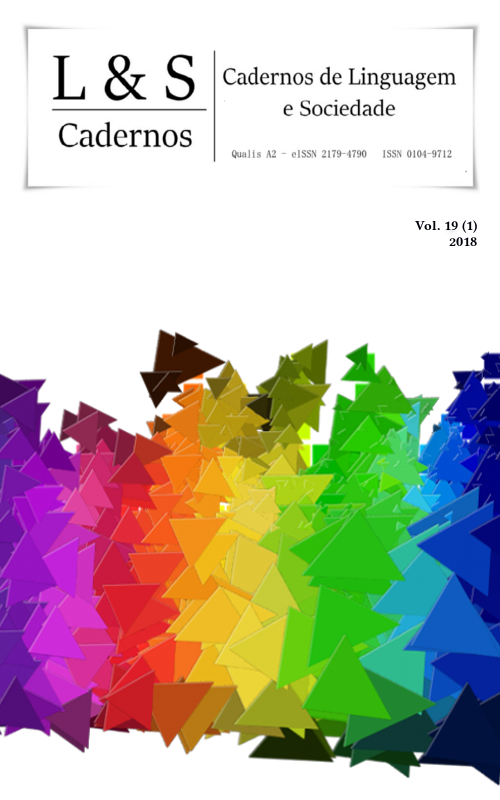The use of nominalization as a resource of impersonalisation in scientific articles written in Portuguese: a study based on Systemic Functional Linguistics
DOI:
https://doi.org/10.26512/les.v19i1.10871Keywords:
Nominalization. Impersonal Constructions. Systemic Functional Linguistics.Abstract
This article analyses the most frequent nominalizations found in a corpus formed by 1225 scientific articles from different knowledge areas, written in Portuguese, randomly collected in the Scielo platform. The linguistic analysis is based in Systemic Functional Linguistics (HALLIDAY, 1985, 1994, HALLIDAY & MATTTHIESSEN, 2004, 2014) and computational tools from WordSmith Tools v. 5 (SCOTT, 2008). The scientific discourse changes the world into names, in stable things when the scientist observes experiments and measures, thinks and understands things. Most part of these uses are explored in this article, that aims to describe how nominalizations are constructed in the discourse, demonstrating its power of pack information, giving the language more abstract, encapsulation and academic. The expectation is that this study will contribute with courses and material design elaborated specifically for graduate and postgraduate students.
Downloads
References
BAZERMAN, C. Modern evolution of the experimental report in Physics: spectroscopy articles in Physical Review, 1893-1980. Social Studies in Science, 14:163-196, 1984.
BHATIA, V. K. Analysing genre: language use in professional settings. Longman, 1993.
BERBER SARDINHA, T. Semantic prosodies in English and Portuguese: A contrastive study. Cuadernos de Filología Inglesa. Murcia, Spain V.9, 1:93-100, 2000.
BERBER SARDINHA, T. Linguística de Corpus. Barueri-SP: Manole, 2004.
BERNSTEIN, B. Class, code and control. v.1. Londres: Routledge & Kegan Paul, 1971.
BIBER, D. et al. Corpus Linguistics: investigating language structure and use. Cambridge: Cambridge University Press, 1998.
BORSINGER, A. Working with disciplinary discourses in the light of systemic functional theory. DELTA: Revista de Documentação de Estudos em Linguística Teórica e Aplicada, 25/1:131-153, 2009.
CORBETT, J. Genre and genre analysis. In L. M. Jacob (Ed.), Concise Encyclopedia of Pragmatics. 2nd edition. 286-292. Oxford: Elsevier, 2009.
DEREWIANKA, B. Grammatical metaphor in the transition to adolescence. In A.-M. SimonVandenbergen, M. Tavernier, & L. Ravelli (Eds.), Grammatical metaphor: Views from systemic functional linguistics, Amsterdam/Philadelphia: Benjamins, 2003.
DAVIES, B. et al. (Eds.), Reading Bernstein, Researching Bernstein. London: RoutledgeFalmer 1989.
EGGINS, S. An introduction to systemic functional linguistics. Londres: Pinter, 1994.
FOWLER, R. Language in the news. Londres: Routledge, 1991.
FRANCIS, G. Labelling discourse. In: M. Coulthard (Ed.), Advances in written text analysis. London & New York: Routledge, 1989. p. 83-101.
HALLIDAY, M.A.K. An Introduction to Functional Grammar. London: Edward Arnold, 1985.
HALLIDAY, M. A. K. e MARTIN, J. R. Writing science: literacy and discursive power. London: Palmer, 1993.
HALLIDAY, M. A. K. An introduction to Functional Grammar. London: Edward Arnold, 1994.
HALLIDAY, M. A. K. The language of science. New York: Continuum, 2004.
HALLIDAY, M. A. K. e MATTHIESSEN, C. M.I.M. An introduction to Functional Grammar. London: Edward Arnold. Third Edition, 2004.
HALLIDAY, M. A. K. e MATTHIESSEN, C. M.I.M. An introduction to Functional Grammar. London: Edward Arnold. Third Edition, 2014.
IKEDA, S. et al. As metáforas e a persuasão em editorial de jornal: um enfoque da Linguística Sistêmico-Funcional. Veredas: UFJF, v. 19, n. 2, 2015.
MORAIS, F. B. C. Entre alhos e bugalhos: os diferentes usos do clítico SE na escrita acadêmica. Doutorado em Linguística Aplicada e Estudos da Linguagem. PUC-SP, 2013a.
MORAIS, F. B. C. As construções médias nos artigos científicos de linguística. Cadernos de Linguagem e Sociedade, v.14, n.2, p. 184-206, 2013b.
MORAIS, F. B. C. & BARBARA, L. Um uso muito particular do clítico SE. Letras (UFSM), v. 50, 2015a.
MORAIS, F. B. C. O uso do processo existencial “haver” na escrita acadêmica ”“ um estudo com base em um corpus de artigos científicos de diversas áreas do conhecimento. (Con)textos Linguísticos (UFES), v. 10, n.14, 2015b.
ROSE, D. Sequencing and Pacing of the Hidden Curriculum: how Indigenous learners are left out of the chain. In J. Muller, A. Autor & B. Davies (Eds.), Reading Bernstein, Researching Bernstein. London: RoutledgeFalmer 1989.
SCOTT, M. R. WordSmith Tools v. 5. Software for text analysis. Oxford: Oxford University Press, 2008.
SWALES, J. M. Language and scientific communication: The case of the reprint request. Scientometrics, v.13, p. 93-101, 1989.
SWALES, J. M. Genre analysis ”“ English in academic and research settings. Cambridge University Press, 1990
SWALES, J. M. & FEAK, C. B. Academic writing for graduate students. Michigan: The University of Michigan Press, 1999.
VEEL, R. The greening of school science: ecogenesis in secondary classrooms. In J. R. Martin & R. Veel (Eds.), Reading science: functional and critical perspectives on the discourses of science. London: Routledge, 1999.
ZHENG, S. YANG, A. e GUANGCHUN, G. Functional stylist analysis: transitivity in englishmedium medical research articles. International Journal of English Linguistics. v. 4.n. 2, 2014.



